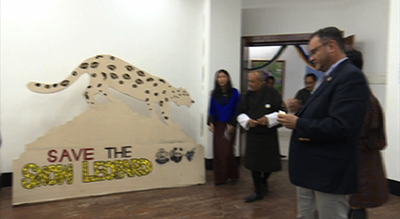 A project to create a life-sized snow leopard origami collage is underway at the exhibition hall of the Royal Textile Academy (RTA) in Thimphu. It was launched at the opening of the Young Pandas Bhutan art exhibition yesterday on the International Snow Leopard Day.
A project to create a life-sized snow leopard origami collage is underway at the exhibition hall of the Royal Textile Academy (RTA) in Thimphu. It was launched at the opening of the Young Pandas Bhutan art exhibition yesterday on the International Snow Leopard Day.
The WWF Bhutan collaborated with VAST Bhutan to create the beautiful art of the elusive animal. The students of 10 schools in Thimphu were engaged in the project.
The project is an on-going one, meaning the art is not a complete work yet. Anyone visiting the exhibition can be a part of it by putting up their names or messages on the origami collage to complete it until Friday.
The fun and engaging art project is aimed at raising awareness on the conservation of the endangered snow leopard among the Bhutanese youth.
WWF Bhutan says the life-size snow leopard origami collage will go on to become a symbol of optimism for the conservation of the beautiful cat species. It is set to become a familiar sight at future snow leopard conservation awareness programmes.
 The four-day Young Pandas Bhutan art exhibition also features around 50 paintings, drawings, and photographs by the Bhutanese youth that capture the theme of living in harmony with nature.
The four-day Young Pandas Bhutan art exhibition also features around 50 paintings, drawings, and photographs by the Bhutanese youth that capture the theme of living in harmony with nature.
Solitary, almost silent and majestically beautiful, the snow leopard is one the most enigmatic cats. It is also one of the rarest and threatened.
The large cat, native to the mountain ranges of Central and South Asia, is listed as Vulnerable on the IUCN Red List of Threatened Species. IUCN stands for International Union for Conservation of Nature.
An ambitious countrywide estimate of the snow leopard population was carried out in 2017 in WWF snow leopard range countries, which includes Bhutan, as part of a series of conservation initiatives.
The estimate, which was done using modern scientific methods, found 96 cats in Bhutan as opposed to the earlier guesstimate of 100-200 cats.
The Jigme Dorji Wangchuck National Park, Jigme Khesar Nature Reserve Park and Wangchuck Centennial Park are a few of the habitats of snow leopard in Bhutan.
Conservation efforts in Bhutan
The Bhutanese government has afforded maximum protection of the snow leopards by listing it as a totally protected species in the Forest and Nature Conservation Act of Bhutan 1995.
And the Forest and Nature Conservation Rules and Regulation 2017 introduced a fine of Nu 1 M for killing a snow leopard.
“We also impose a fine of Nu 300,000 for illegal possession of snow leopard skin or snow leopard bones,” Tshering Zam, a Senior Forestry Officer with the Nature Conservation Division of the DoFPS, said.
The killing of snow leopard is graded as a fourth degree felony in the Penal Code of Bhutan.
The Department of Forest and Park Services (DoFPS), with support from conservation partners, has implemented various measures to conserve and protect snow leopards and their habitat in the country.
“We have SMART patrolling system for all the forestry staff to enhance monitoring and enforcement, and to protect and conserve snow leopards. We also have zero poaching strategies in place,” Tshering Zam said.
The predator is often hunted for its fur, bones and organs.
“Human-wildlife is another threat to its existence. People kill snow leopards in retaliation to deaths of livestock and crop destruction caused by the predator,” Dr Roberto Troya of WWF said.










